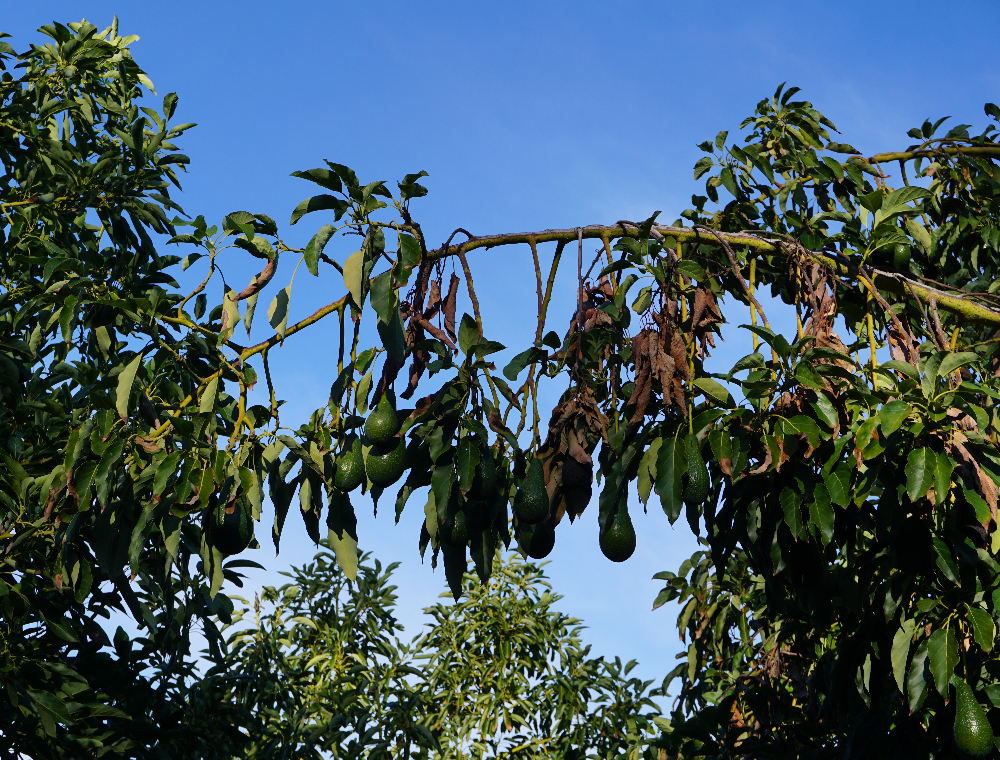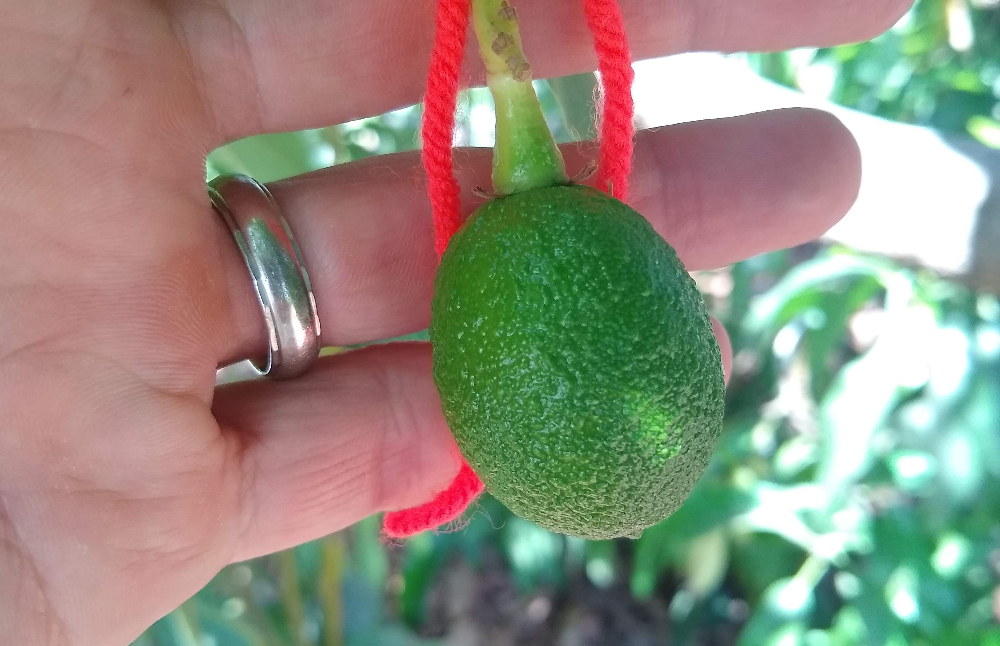At times an avocado tree will set more fruit than it can grow to maturity without negative consequences. The tree might be too small such that carrying much fruit will stunt its growth, or the fruitlets might be too numerous on a single branch such that it will bend from the weight of the fruit and get sunburned or even break.

Or the fruitlets might have set on a low branch and will be resting on the ground once they are big and heavy, which can cause peel problems.
In these situations you might want to remove some fruitlets. But which do you remove?
Fruitlets that have obvious defects, such as scarring or damage to their stem, should go. Fruitlets hanging outside the canopy and vulnerable to sunburn should also go.
How about choosing between small and large fruitlets? Last July, a Yard Posts reader named Brandon asked if the young fruit on his Hass tree that were of different sizes then would ultimately all harvest at about the same size, or would the small ones remain small.
I replied: “They might be different sizes just based on when they started growing. Some might have been pollinated in March while others weren’t pollinated until May, for example.” Then I suggested that we both tag a few of the fruit that are exceptionally big or small at that time (July) and see if they end up remaining relatively big or small at harvest time.
So in July I tagged the smallest and biggest young avocado fruit on five of my trees. I revisited the trees last week (early January). See the results in this video:
Results summarized:
Edranol- no change in relative size; no drop
Gwen- small dropped, large remains
Hass- small dropped, large remains
Reed- both dropped
Pinkerton- no change in relative size; no drop
Speculation
Why the difference in fruit drop between varieties? Most fruit drop occurs soon after the fruit is set, that is, when it is very small (think: pea size). The varieties that had no drop (Edranol and Pinkerton) both start to flower earlier than the varieties that had some drop. And the varieties that dropped only their small fruit (Gwen and Hass) are mid-season bloomers.
The flowering season of Reed extends much later than the other varieties, even into early July at my place, as does its season of normal fruit drop. Therefore, it would have been more useful to tag Reed fruit in August or September.
Conclusion
I don’t think I can make any hard conclusions based on what happened to those few fruit. I would need to tag many more fruit for that.
However, as of now, if I were choosing between small and large fruitlets to remove, I would remove the small ones because they seem more likely to drop and more likely to remain smaller at maturity.
This summer I’ll tag more avocado fruitlets to see if I get results that follow the pattern from last year.
Update
On March 19, 2023, I made a final check of these tagged avocados before starting to harvest and found that the results were the same as summarized above. There had been no further drops and the relative size differences remained.
Related posts:
“Should you remove avocados from a small tree?”
“Avocado fruit drop: Why? When? How many?”
All of my Yard Posts are listed HERE
Your direct support is what The Yard Posts runs on. Thank you!




Hi Greg – as I was reading this week’s post, I was thinking “hey! This sounds like my question!” To see you call it out explicitly made me smile.
I will admit to being as rigorous in my methods. My hass tree is still so young that it only set about 20 fruit. Only a couple dropped after that thread in July, and since then the small ones remained small compared to the roughly five avocados that to me were “normal” size. Of course, if I culled all of the small ones I’d have a much smaller crop, so I’m not quite ready to do that. But I think once fruit sets this year I will do so more aggressively.
I got greedy and harvested a hass in mid January. Was definitely too soon. The button only loosened after a couple weeks and it was very rubbery. I’m waiting until March.
Just added a GEM to the collection. Not great for filling out the harvest schedule, but I’ve always wanted to try that tree.
As always, thanks for the great garden content.
Oops – NOT being as rigorous
I wonder what would happen if you left both the sizes on the tree until they dropped naturally – would they end up the same size or would the small fruit never grow as large regardless of time given to grow. Is there some terminal size for each fruit?
Hi Matt,
Good question. I haven’t removed the strings from any of those avocados yet, and I’ll leave the fruit on the trees until they’re at the tail end of their harvest season to see if the size differences remain. My guess is that nothing will change. We’ll see.
So glad you included this post. I’ll try removing the small ones next season. My problem is many of them are way up high on the old mystery (Lyon TBD) tree, and I worry that with the extended fruit picker I’ll disturb more of the fruit than necessary. A tall ladder is out of the question for me because of my age- unless I hire someone for the task. I still have a few kumquat size plus avocados on the old Fuerte, which haven’t grown much at all. Should I give up waiting and remove them now? The flowers look like they’ll be opening pretty soon. Thanks!
Hi Greg,
Apples don’t change relative size from fruit set to ultimate ripening size: small ones never catch up.
I recall reading in a pollination study that Avocados drop in response to stresses, and drop in direct relation to resources invested: Big, early set fruit was the last to get dumped, tiny late set fruit was the first. (totally skewed the results of DNA paternity analysis)
After some time, when both small and large have been pumped-up, the tree wants to protect its’ investment, so holds both pretty well. Dropping the smaller might not continue to happen unless things get really bad, and there might be other factors like wind and the hot side of the tree, etc. but the tendency is still there. Hopefully thinning is done way before this anyway.
Hi Greg, I have a Lamb Hass, a Reed, a Hass, and a Pinkerton. I am thinking to buy a type B avocado tree. Can a Sharwill cross-pollinate all the trees? If not, what is the best type B to cross-pollinate all the trees? Thank you.
Hello Greg,
I’m in Florida right now on vacation and trying to find a Pinkerton with no luck, any suggestions. I live in N.Y. Where the weather gets pretty cold ,zone 6A. I was looking for 3 medium sized cold hearty trees that could give me avocados mostly year round. I’ll be planting them in the ground in a greenhouse with about 15’ height to the peak. I don’t anticipate the temperature dropping below 30F with all the glass and a backup space heater for night time. The problem is that winters are long: I was thinking Pinkerton; Lila and then Bacon for a B pollinator.
Do you think this is a good choice or would you recommend something else. I have also found Fantastic and Joey at a local nursery but I understand that they are very small fruit.
Thanks for your help,
Angelo